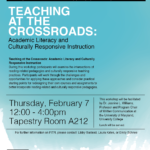Does Reading Matter? FIG Meeting #1
Facilitator: Michelle Gabay,
English (Esther.Gabay@kbcc.cuny.edu)
for the Faculty Initiative on Teaching Reading (FITR)
Does Reading Matter? FIG April 22, 2020 at 12:00
Goals:
- Learn how to use and embed active learning and reading technology into your emergency online course.
- Learn how to access and view evaluation features in Perusall
- Experience Perusall tool as a student, so you can better understand how a student in your course might feel working though this kind of active and social learning platform.
We got started by signing up as students and enrolling in the Does Reading Matter? FIG course. Through Zoom’s screen sharing function, Michelle took us on a general walk-through of Perusall to get a sense for how the site worked, how to navigate the first few instructor set up phases, some of the personal and collaborative annotating features, and we looked at what the collaborative annotation actually looks like on the instructors’ side. The appearance of so many annotations felt daunting to some FIG participants, but when we segued into Matthew Gartner’s presentation, he showed us an efficient way to keep track of individual students’ comments and activity, and how he has set his site to score what he values. During the presentation, Matthew showed us how he has been using Perusall in his current online English classes, with an emphasis on Perusall’s evaluating tools. The last feature Matthew shared with us, was his work with the integrated Discussion room, which is neatly embedded in Perusall’s course menu. Students could read and annotate a text, and then move naturally to the Discussion space to follow up on their reading and share their ideas with their instructor and classmates.
We then spent some time tinkering with Perusall and annotated the first few pages of Allison Walker’s article “Perusall: Harnessing AI Robo-Tools and Writing Analytics to Improve Student Learning and Increase Instructor Efficiency in our course.” We did this really just to get a sense for what it would be like to engage in this type of annotating and embody the student experience. Towards the end, we spent five minutes in Perusall’s Discussion space reflecting on our process in writing, and then verbally shared our thoughts.
Reflection: After spending some time annotating the first 1-2 pages of Walker’s article, spend a few minutes reflecting on what the process was like for you. Could you imagine integrating Perusall into your Bb course.
Interesting questions and points that came up during the meeting:
- Some folks were concerned that it might be disorienting for students to navigate off Bb to work on Perusall. Ideally, Perusall could be embedded into our Blackboard learning management system, but as a work-around, one could add a section on their Bb course menu called “Perusall” or “Readings” or “Content” and embed a link into a blank weblink page, which would transport students to Perusall quite easily.
- Some people thought the interface felt more like popular social media sites, which could offer students a tool that feels more familiar or comfortable.
- Others noted the ethical and pedagogical issues with AI grading tools. There is no doubt that AI grading and tutoring are problematic for a number of serious reasons, but one could set the assignment to “optional,” so grades were not calculated. Some faculty members mentioned that they could use the grading tool as a way to gauge how actively each student was annotating, but not necessarily use the score generated by Perusall in their notes and official grades to students.
- One of the critiques raised, pointed out that Perusall seems to value quantity of annotations, over quality of annotations. For some disciplines quantity might suffice, but other instructors spend a good deal of time encouraging substantive and thoughtful commentary, so the site may undermine these efforts. One instructor who uses Perusall said she notifies students with a quick note in Perusall about developing more substantial comments.One could @student in Perusall in a response and provide a quick note.
- Another instructor noted that she liked the social component and believes it can motivate students to complete the readings. In addition, it can give students a way to track their own reading development and processes, and have a record of it stored in Perusall. However, she also recognized that she would need to slowly introduce certain layers of these processes to her students as the semester unfolded.
We’re all still beginning to learn Perusall, so our expertise and knowledge are definitely limited. We hoped, though, that by offering this FIG focusing on Perusall and collaborative annotating, we could give instructors, who are concerned about the quality of their students’ reading in online classes, some other options that might help them foster and build active reading habits in their online classes. Some faculty have said they will continue to build on what they learned at this FIG and tinker some more, and perhaps implement Perusall into their summer or fall courses.
To support faculty, I am happy to talk to anyone who might be interested in learning more about this program. Just email me at Esther.Gabay@kbcc.cuny.edu and we’ll set up a time to talk.






